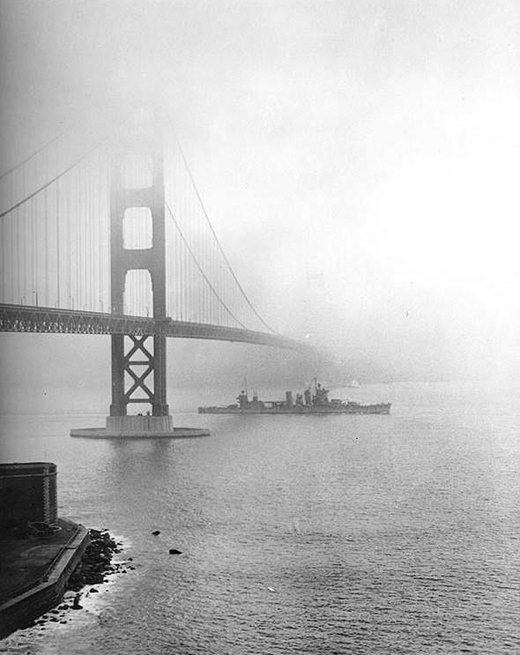Air Operations, Aleutians
3 28th Composite Bombardment Group B-26s and 4 XI Fighter Command P-38s attack a wrecked ship at Kiska, and the P-38s also bomb and strafe the submarine base, the seaplanes base, and gun emplacements.
[Air Operations, CBI
INDIA- 7th Heavy Bomb Group B-24s attack but do not hit Japanese Navy shipping off Port Blair.
Air Operations, Europe
BOMBER COMMANDEvening Ops:
- 82 aircraft of 1, 4 and 5 Groups and the Pathfinders attack Turin: 48 Halifaxes, 20 Lancasters, 8 Stirlings and 6 Wellingtons.
- More than half the force turn back before crossing the Alps because of severe icing conditions; 28 crews claim to have bombed Turin, but the city reports only 3 high-explosive bombs and a few incendiaries with no casualties.
- 3 Halifaxes and 1 Stirling are lost.
- 26 Wellingtons lay mines off the Biscay ports and in the Frisians and there are 4 OTU sorties.
- There are no losses.
Air Operations, New Guinea
V Bomber Command B-25s and B-26s attack the airfield at Lae, and the B-26s also hit the airfield at Buna and other targets of opportunity.
[Air Operations, Solomons
- 5th and 11th Heavy Bomb group B-17s attack the airfield at Munda Point, New Georgia.
- A VMF-122 F4F downs an A6M2-N 'Rufe' fighter-bomber over Guadalcanal, and 14 Marine Corps SBDs attack 11 Japanese destroyer-transports off northern New Georgia but score no hits.
Air Operations, Tunisia
XII Bomber Command B-25s, with fighter escort, attack rail bridges at La Hencha.
[Eastern Front
The Red Army retains the initiative everywhere. The Russians make progress in the Stalingrad sector, in the great bend of the Don and in the Caucasus. Von Manstein's 4th Army is under heavy pressure east of Stalingrad. In the Caucasus, Army Group A establishes a defensive line further back, near the Terek River.
Men of the 24th Panzer Division |
 |
The 11th Panzer Division is forced to fight off additional Soviet attack across the Chir at Lissinski and Nizhne Kalinovski.
Manstein aims to launch WINTER-STORM on the 12th, Hoth has at his disposal the 23rd Panzer Division with 30 tanks and the 6th Panzer with 160 panzers and 40 self-propelled guns. The VI Rumanian Corps covers the left flank with the 7th Rumanian Corps protects the right. Behind the armored wedge is the lifeline of the 6th Army, a fleet of 800 lorries loaded with 3,000 tons of supplies. Hoth's force amounts to 30,000 men, with which he is to punch through the 51st Army, cross 80 miles of Steppe and link up with the 6th Army.
Army Group P begins its withdrawal from the Caucasus. Heavy fighting erupts along the Terek as the Germans fall back to the Mozdok-Elitsa line.
[France
'Cockleshell Heroes' Raid. 5 canoes, each manned by 2 British Commandos, are launched from the submarine Tuna on December 7. 3 are lost, but 2 survivors travel 146 km up the Gironde River to Bordeaux, where 4 merchant ships, a tanker and a naval auxiliary are disabled with limpet mines. 6 captured Commandos are later executed by the Germans.
[Guadalcanal
Tanaka leads the fourth supply mission. They are attacked from the air but planes are driven off. 11 ships are on this mission. At midnight just south of Savo the force is attacked by a swarm of PT boats. 7 destroyers drop 1,200 drums of supplies and begin to withdraw. The PT boats attack. 2 manage to hit the Teruzuki. The ship catches fire which reaches a magazine and the destroyer blows up. Tanaka on the bridge loses consciousness and when he comes to, the ship is sinking.
Naganami comes along to pick up survivors. Tanaka's flag is transferred. As soon as he gets on board, the Naganami and the Arashi take off at high speed, leaving many survivors on the sinking ship, as the PT boats attack again. Lifeboats are dropped and some survivors manage to get to Guadalcanal and the Japanese lines.
[Mediterranean
U-443 sinks the British destroyer Blean 11 miles west of Oran, Algeria with the loss of 89 of her crew. 94 survivors are picked up by the British destroyer Wishart.
[New Guinea
There is a lull in activity. On the Urbana front, the 3rd Battalion of the 127th Infantry completes the relief of the 2nd Battalion, 126th Infantry, in line. During the night ships begin to arrive in Oro Bay bringing supplies for the Allies; the first convoy unloads 4 light tanks of the Australian 2/6th Armored Regiment, the first tanks to the island.
[North Africa
ALGERIADuring the night 3 'pigs' of the Italian navy enter Algiers harbor and sink 4 ships in an Allied convoy.
LIBYA8th Army begins to advance as Montgomery gives the order to resume the offensive. The British are to attack El Agheila on the 14th. RAF activity over Axis logistic centers is intensified in preparation for the attack.
TUNISIAAnother German attack at Medjez el Bab from the north and east is repulsed. The British 6th Armored Div begins arriving in the forward area. Combat Command B, US 1st Armored Div, is relieved in the Bédj area by the 11th Brigade, British 78th Div, and is placed in the V Corps reserve.
[ USS San Francisco Returns to San Francisco |
 |